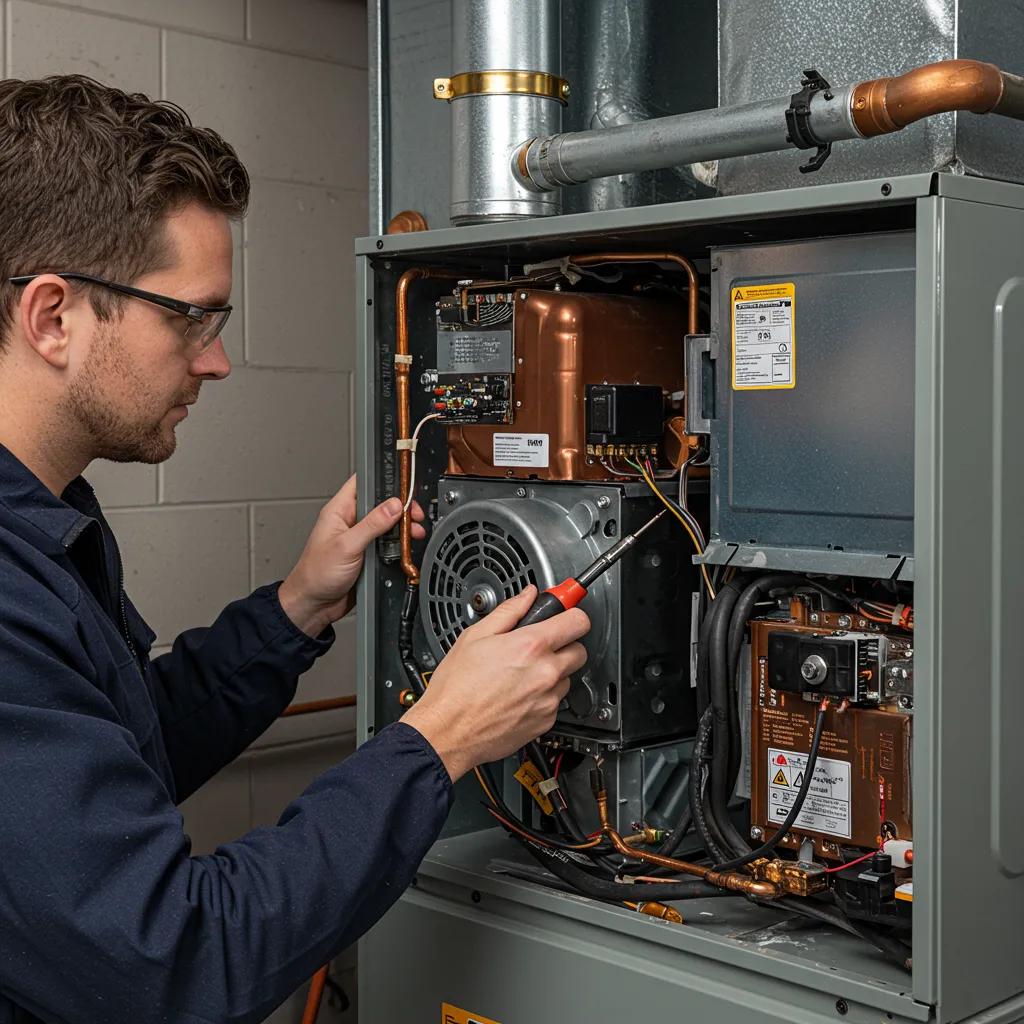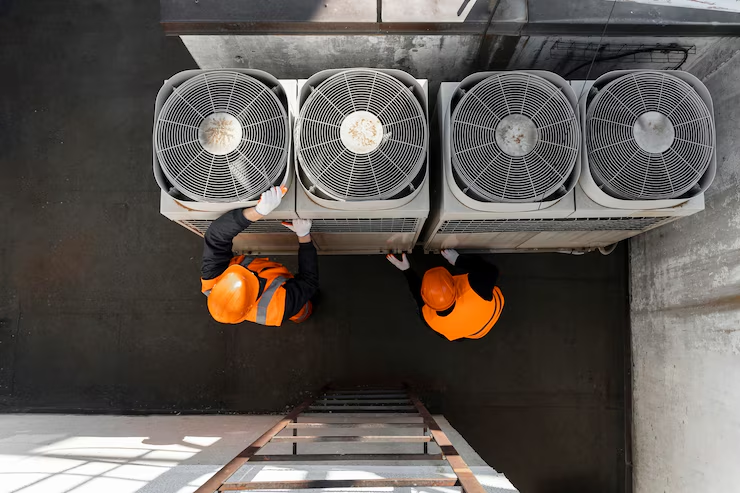
Essential Signs Your Furnace Requires Maintenance and Care
Is your furnace showing strange signs? Learn the essential indicators that signal the need for maintenance and care to avoid costly issues.




Spotting Furnace Trouble: Your Guide to Maintenance Needs and Common Issues

When your furnace starts showing early signs of trouble, it often means performance, safety, or efficiency is taking a hit Catching these indicators early can save you from unexpected breakdowns, wasted energy, and potential hazards like carbon monoxide This guide will walk you through common furnace maintenance signals and what each symptom—from odd noises and short cycling to strange smells and visible rust—tells you about underlying problems that need attention You’ll learn simple troubleshooting steps, crucial safety actions for gas or combustion-related smells, and how to tell if a quick fix is enough or if it’s time for a professional check-up We’ll also cover how Yuma’s dusty climate and seasonal use can speed up filter clogs and wear, linking symptoms to parts like the blower motor, heat exchanger, burners, pilot light, air filter, thermostat, and ductwork Keep reading for a list of high-priority signs, easy homeowner checks, tables that match symptoms to urgency, and clear guidelines on when to call a licensed technician to keep your home comfortable, efficient, and safe.
What Are the Top Signs Your Furnace Needs Some TLC?
A furnace that’s due for maintenance usually shows symptoms affecting your safety, comfort, or how much you spend on energy These include persistent unusual noises, inconsistent or weak heating, higher energy bills, frequent on-off cycling, strange odors, a yellow pilot light, or excessive dust These visible signs often point to issues with specific components like the blower motor, heat exchanger, burners, filters, thermostat, or ductwork Addressing them early helps maintain efficiency and safety Here’s a quick rundown of the most common warning signs homeowners encounter, designed for quick recognition and immediate action Following this list, you’ll find a handy table that pairs each symptom with likely causes and recommended urgency, so you can quickly assess and address any issues.
Keep an eye out for these common furnace warning signs:
- Unusual banging, rattling, squealing, or grinding sounds coming from the furnace unit.
- Heating that’s uneven, with cold spots or rooms that never feel warm enough.
- A noticeable jump in your energy bills without any change in how you use your heating.
- The furnace cycling on and off frequently (short cycling) or running non-stop.
- Strange smells, like gas, burning insulation, or a musty odor.
- A pilot light that’s yellow instead of a steady blue, or visible rust and corrosion on parts.
This list covers the most critical signs The table below connects each symptom to potential causes and how urgently it needs professional attention.
How Do Strange Furnace Noises Point to Mechanical Issues?
Unusual noises from your furnace are a key diagnostic clue because specific sounds often relate to particular components Banging might signal delayed ignition or stress from a cracked heat exchanger, while rattling could mean loose panels or debris inside Squealing and grinding typically point to worn blower motor bearings or a motor that's starting to fail When your furnace makes these sounds, it usually means there’s mechanical stress or contact that’s hindering performance, increasing energy use, and could lead to a breakdown if not addressed.
Homeowners can do a quick check by making sure cabinet panels are secure and looking at visible belts and filters Just remember to power down the unit before touching anything and avoid taking it apart If the noises are persistent, severe, sudden, or happen alongside odors or cycling issues, it’s best to get a professional inspection to prevent further damage and ensure safety.
These diagnostic steps naturally lead to checking how well your furnace is heating, as mechanical problems often show up as uneven or weak warmth.
What Does Uneven or Weak Heating Tell Us About Your Furnace?

Uneven or weak heating usually signals problems with airflow, heat distribution, or combustion Clogged filters restrict airflow, leaks in ductwork or blocked vents create cold spots, and failing burners or ignition systems can result in lukewarm air Essentially, the furnace isn't delivering enough heat—either it can't generate enough due to combustion issues, or the warm air can't reach rooms effectively because of distribution problems This makes the furnace run longer and puts more strain on its components As a homeowner, you should start by checking filters, making sure vents are open, and verifying your thermostat is calibrated correctly Comparing temperatures from room to room can help pinpoint duct or zoning issues If these simple fixes don’t even out the heating, a technician should check the heat exchanger, blower motor, and ductwork for leaks or blockages.
Fixing distribution problems also cuts down on wasted energy and prevents the recurring mechanical stress that leads to noise and component wear.
Why Are Higher Energy Bills a Red Flag for Furnace Issues?
When your energy bills go up without any changes in your habits, it usually means your system isn't as efficient as it should be This can be due to dirty filters, fouled burners, a struggling blower motor, poor combustion, or a compromised heat exchanger Any of these issues forces your furnace to run longer or work harder to keep your home at the desired temperature The underlying reason is reduced heat transfer or airflow, which increases runtime and fuel consumption while also speeding up wear on components and making breakdowns more likely Homeowners can keep an eye on usage patterns, inspect and replace filters, and note how long the furnace runs before and after basic maintenance to see if it makes a difference Professional tune-ups, including combustion analysis and blower inspections, typically restore efficiency and can lead to noticeable savings on your monthly bills.
Understanding efficiency loss is closely tied to how your furnace cycles, as many efficiency problems show up as short or long cycling that needs to be addressed next.
How Does Furnace Age and Visible Wear Affect Maintenance Needs?
A furnace’s age and visible wear play a big role in how often it needs maintenance and when it’s time to think about replacing it Components naturally degrade over time, and environmental factors—like Yuma’s fine dust and frequent use cycles—can speed up corrosion and part failure.
While a well-maintained furnace can last its typical lifespan, signs like rust, frequent breakdowns, recurring repairs, and declining efficiency suggest it might be better to replace it than keep fixing it The issue is cumulative wear: rust weakens structural parts, corroded heat exchangers reduce heat transfer and increase CO risk, and repeated repairs mean you’re likely spending more than you would on a new, efficient unit Homeowners should weigh repair costs against the energy savings from modern, high-efficiency furnaces and consider benefits like extended warranties and professional installation when deciding whether to repair or replace.
The table below outlines age ranges, common issues, and recommended actions to help homeowners make informed decisions about repairing versus replacing their furnace.
What Is the Typical Lifespan of a Furnace in Yuma’s Climate?
Furnaces typically last about 15–20 years with regular maintenance However, Yuma’s dusty conditions and usage patterns—which often involve frequent fan cycles and periods of heavy use—can accelerate filter clogging and wear on components, potentially shortening its effective lifespan The mechanism here is increased particle abrasion and overheating from restricted airflow, which puts stress on the blower motor and heat exchanger, leading to more frequent maintenance needs To get the most life out of your furnace, consider a more frequent filter replacement schedule, keep vents and returns clear of dust, and schedule preventative maintenance at least annually, or more often if the system shows symptoms Regular professional inspections can help catch early heat exchanger issues and maintain indoor air quality.
These lifespan considerations lead directly to identifying visible signs of wear that suggest it might be time for a replacement.
Which Visible Signs Suggest It’s Time to Replace Your Furnace?
Visible signs that point towards replacement include extensive rust, cracks in the cabinet or heat exchanger, repeated component failures, and persistent inefficiency even after repairs Performance indicators like frequent short cycling and rapidly increasing energy bills also signal the end of a furnace’s useful life The underlying reason for replacement is compromised structural integrity and systemic inefficiency that repairs can’t economically fix Continuing to run such equipment can also pose safety risks, including a higher potential for carbon monoxide leaks Use a replacement decision checklist: track how often and how much you’ve spent on repairs, compare your current system’s efficiency to newer models, and note any structural corrosion or visible cracks Get a formal assessment from a licensed professional; installing a modern unit offers benefits like improved energy efficiency and potential for extended warranties to protect your investment.
Replacing an older furnace also provides an opportunity to enhance your home’s indoor air quality and explore options like heat pumps or ductless mini-splits for complete home comfort.
How Does Rust, Cracks, and Corrosion Impact Furnace Performance?
Rust and corrosion degrade heat transfer surfaces, weaken structural parts, and can lead to cracks in the heat exchanger These cracks can allow combustion gases to enter your home’s air supply, compromising both efficiency and safety The mechanism involves material loss and structural weakening: corroded surfaces transfer heat less effectively, and small cracks can widen under thermal stress, causing leaks and inefficiencies Signs to look for include visible rust flakes, discoloration near combustion areas, and soot buildup.
Any suspicion of a cracked heat exchanger should prompt an immediate professional evaluation due to the risk of carbon monoxide Professional diagnosis typically involves a visual inspection, pressure testing, and combustion analysis to determine if repair is safe or if replacement is necessary.
Addressing corrosion promptly prevents minor issues from escalating into safety hazards and helps you make informed decisions about professional installation options with warranty coverage.
How Does Poor Indoor Air Quality and Excessive Dust Signal Furnace Problems?
Poor indoor air quality (IAQ) and excessive dust often stem from furnace-related issues like dirty filters, leaky ductwork, or worn components that recirculate dust and allergens throughout your home Yuma’s arid, dusty climate makes these problems even more pronounced The mechanism involves the circulation of fine particles: a clogged filter or compromised ductwork allows dust to bypass filtration and settle on heat exchangers and blower components, reducing efficiency and increasing respiratory irritants Homeowners should check filters regularly, consider using higher-MERV filters suitable for dusty climates, and look for visible dust around vents or inside the furnace cabinet Addressing IAQ issues not only improves occupant health but also reduces strain on your furnace Professional services like duct cleaning, filter upgrades, and IAQ system evaluations can provide significant improvements.
Below are practical steps and maintenance tips that can enhance IAQ and reduce stress on your furnace.
Why Are Dirty Filters and Clogged Vents Common in Yuma Homes?
Dirty filters and clogged vents are common in Yuma homes due to the prevalence of fine dust and sand, along with frequent fan cycles that quickly load up filters and duct surfaces with particles Homeowner habits, like not changing filters often enough, also contribute to the problem The mechanism is accelerated particle buildup: the high concentration of local dust overwhelms standard filter replacement schedules, leading to restricted airflow and increased blower runtime Recommended actions include using filters designed for local conditions, checking and replacing filters more frequently than the manufacturer suggests, and keeping outdoor air intake areas sealed against windblown dust If dust persists even after routine filter care, have your ducts professionally inspected, as leaks or compromised seals can recirculate outdoor dust and degrade indoor air quality.
These preventative measures reduce strain on your filter and extend your furnace’s life while improving comfort and respiratory health.
Frequently Asked Questions
1 How often should I schedule furnace maintenance?
It’s generally recommended to schedule furnace maintenance at least once a year, ideally before the heating season kicks off Regular check-ups help ensure your furnace runs efficiently and safely, cutting down the chances of unexpected breakdowns In dusty areas like Yuma, you might need more frequent inspections to handle issues like clogged filters and dust buildup Homeowners should also consider scheduling extra maintenance if they notice any warning signs or if their furnace is over 10 years old.
2 What are the risks of ignoring furnace maintenance?
Skipping furnace maintenance can lead to several risks, including lower efficiency, higher energy bills, and potential safety hazards like carbon monoxide leaks Over time, neglecting maintenance can cause more serious mechanical failures, leading to costly repairs or even needing a full system replacement Plus, a poorly maintained furnace can harm your indoor air quality, potentially causing respiratory problems for your household Regular maintenance helps reduce these risks and keeps your furnace running safely and effectively.
3 Can I perform my own furnace maintenance?
Homeowners can handle some basic maintenance tasks, like swapping out air filters, checking thermostat settings, and making sure vents aren’t blocked However, more complex jobs, such as inspecting the heat exchanger or cleaning internal parts, should be left to licensed professionals Trying to do advanced maintenance without the right training can create safety hazards or damage the system further It’s best to consult a qualified technician for thorough inspections and repairs.
Conclusion
Knowing the signs that your furnace needs maintenance is vital for keeping your home safe, efficient, and comfortable By addressing issues like unusual noises, inconsistent heating, and strange odors promptly, you can avoid costly repairs and improve your indoor air quality Don’t wait for a breakdown; take proactive steps to maintain your furnace and ensure it lasts Contact Precision Heating and Cooling LLC today to schedule your inspection and gain peace of mind with our expert services.


Financing Header/ Maintenance Plan/ Promotions
Financing Options Available: Get the comfort you need now with flexible payment plans.

.webp)








